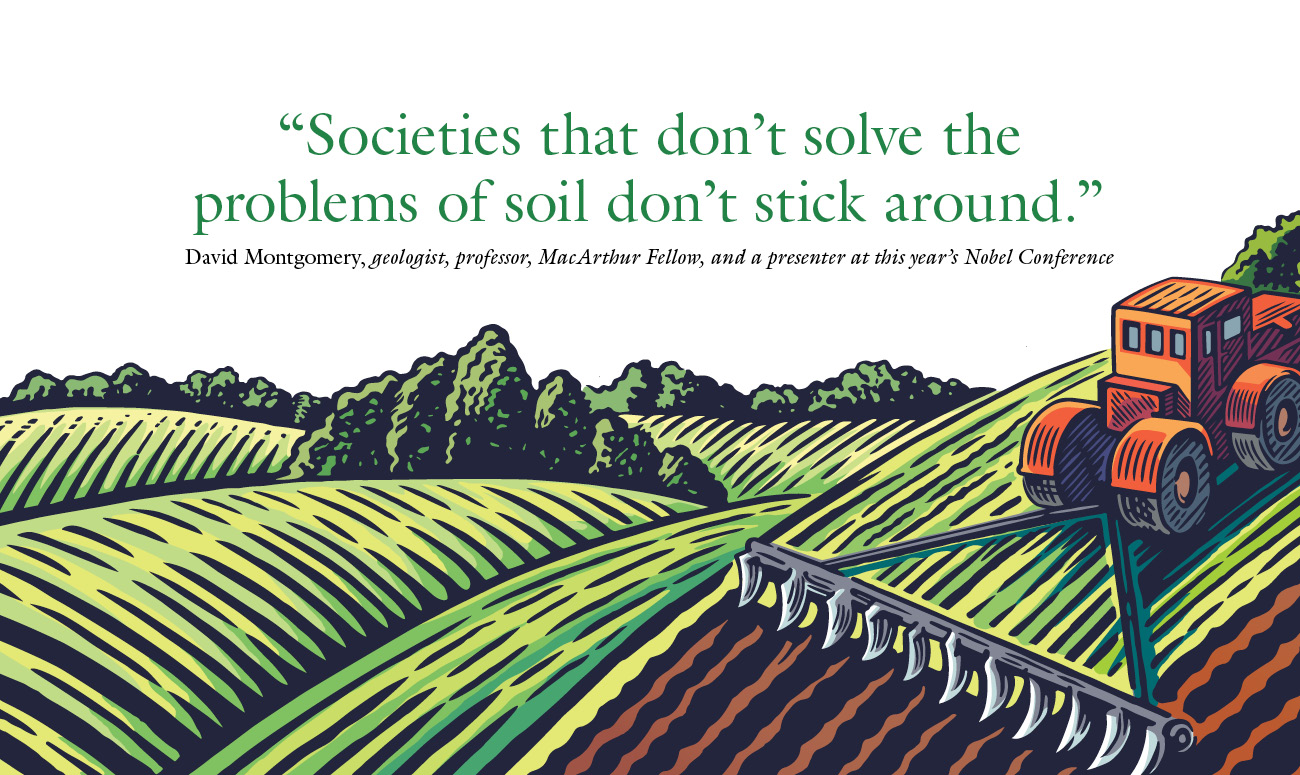Come and consider—with leading world experts—the complexity of soil and the global challenges we face protecting it. Attend this year’s Nobel Conference on Living Soil: A Universe Underfoot.
There are more organisms in a handful of soil than there are people on Earth, than there are stars in the sky. Some estimates put the number of organisms at 100 million times more.
Let that sink in for a moment.
“It really is a universe,” says Laura Triplett, geology and environmental studies professor at Gustavus. Rocks, air, water—we could all come up with a shortlist of items found in soil. But there’s so much more. “And it’s not at all dead,” says Triplett. “By definition, soil is alive, with life processes, chemical processes, and geologic processes.”
The scope of life contained in the world’s soil is so vast that scientists are just now beginning to understand it. And the more they discover, the more we can see soil’s potential to help and heal our environment, our food and agricultural systems, and our bodies.
Soil may be a very thin layer on our planet, but it is an integral base layer of life. “Soil is the basis of all life as we know it,” says Nobel Peace Prize recipient Rattan Lal, scientist and professor at The Ohio State University and the University of Iceland.
And at this moment in our scientific history, you might say we are on the ground level of discovery of soil’s potential, propelled by new scientific understandings of life at the smallest level. With new knowledge of soil, we are imagining answers for some of the world’s greatest challenges—from how to grow the most nutritious food to how to combat climate change.
Through science, we are now uncovering soil’s tremendous importance, and it’s incredible potential.
Healthy Soil = Healthy Planet
The science of soil may be microscopic, but the problems of soil misuse are enormous, global, and very serious.
“Climate change, food insecurity, water quality, species extinction—all have a base problem in soil,” says Lal.
When soil is rich, yield is high—in both volume and nutrients. With the advancements of modern farming during the past century, particularly with nitrogen-phosphorous-potassium fertilizer and tilling machinery, “we got it half right, with chemistry and physics,” says David Montgomery, geologist and professor at the University of Washington and a MacArthur Fellow. “But we left biology off the table.” With a richer understanding of soil’s biological processes at the microbial level comes better solutions for caring for it. Says Jack Gilbert, founder for the Earth Microbiome Project and a professor of surgery at the University of Chicago, “We live on a microbial planet. If we don’t understand microbes, we don’t understand the world at all.”
Case in point: water filtration. A one percent increase in soil organic matter (microorganisms, decaying plants, etc.) helps soil hold 20,000 gallons more water per acre. In water-scarce climates, enriching the soil makes an uninhabitable landscape habitable.
From literally the ground level, these issues of soil health fall within the farmer’s purview. Farming is where science meets people, notes Frank Uekotter, a professor of environmental humanities at the University of Birmingham, United Kingdom. “You get factors that are imminently local and distinctive,” he says. Take, for instance, our American Midwest—the best soil in the world plus the most developed economy in the world equals opportunity for both wealth and disaster, for innovation and corruption, with the safety of the world’s food production at risk.
If we want a safe food, a safe world, and a habitable planet, we need to pay heed. Says Lal, “You cannot improve the health of people and the environment without improving the health of the soil.”
The Story of Soil
The science is new, but our cultural stories and world histories seem to have always known of soil’s importance.
“When you look at the scriptures—Hebrew, Christianity, Hinduism, Islam—they all recommend that Mother Earth be cherished,” says Lal.
“The history of soil is the history of civilization,” says Uekotter. It is not always a pretty one. “One civilization after another declined because it did not use the soil properly,” he says. Montgomery concurs. “The degradation of soil impacted societies from Mesopotamia to the Dust Bowl.”
And yet, the dangerous undervaluing of soil persists. Uekotter points to the “mind of monoculture” pervasive throughout history in a variety of societies and commodities—from bananas to soybeans. We know the science and history that argues against monoculture, yet we continue with systems and mindsets that perpetuate it.
Our preferred narratives of soil are often the result of differing perceptions and interests. As professor and researcher Claire Chenu, at AgroParisTech, told the U.N. in 2015, “Land planners see soils as a surface that can or cannot be built on. Farmers see soils as the medium where plants grow, and people involved in water quality see soils as buffers.”
And many of us don’t see it at all. “Soil is a hidden part of nature,” says Lal. “We cover it with buildings, we mine it, we take it for granted.” When soil’s essential functions in our world are unknown and unseen, “then we have no value for it.”
As we begin to understand the secrets of soil at the microscopic level, soil’s value rises. At least in the communities with their ears to the ground on perspective shifts, like scientists and farmers. But what about educators, artists, corporate leaders, and policymakers? What story are they being told, and telling, about the importance of soil to the world?
If we are to value what we know is an integral part of life here on Earth, “We need to think about soil between both the lenses—the humanities and the scientific knowledge,” says Uekotter. “Learning about the complex factors that are coming together in the soil—what a balancing act it is.”

Leave a Reply